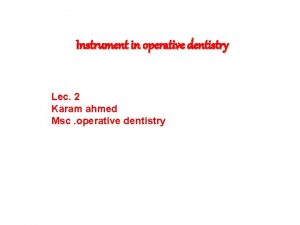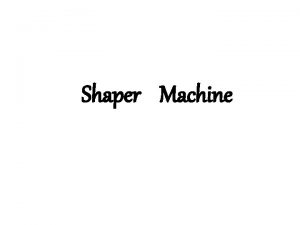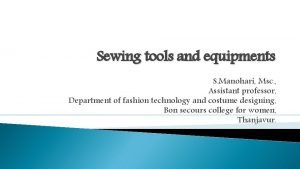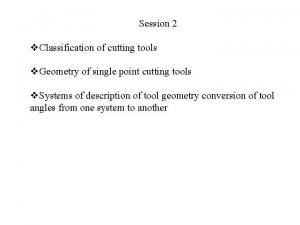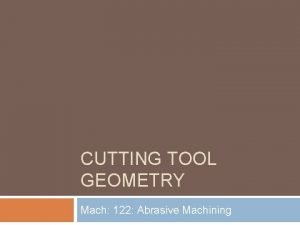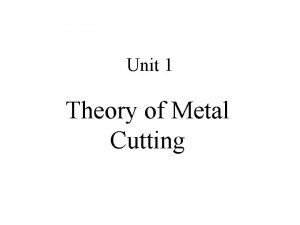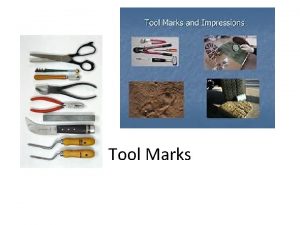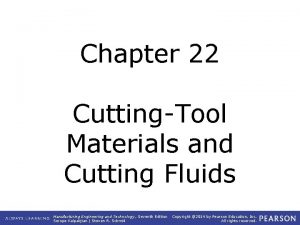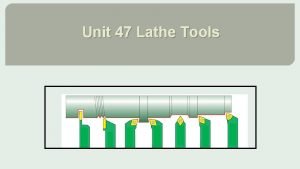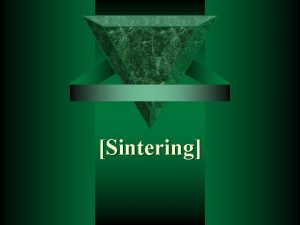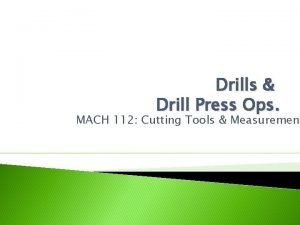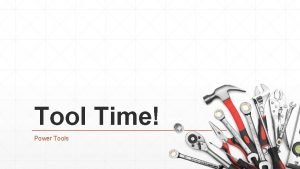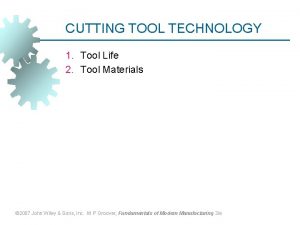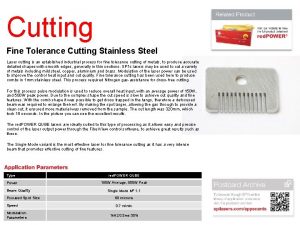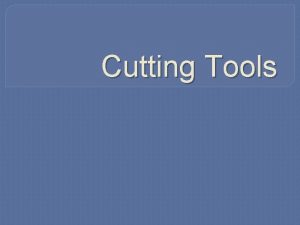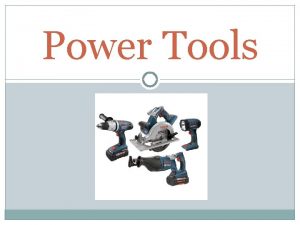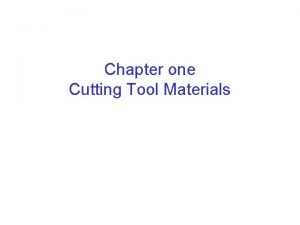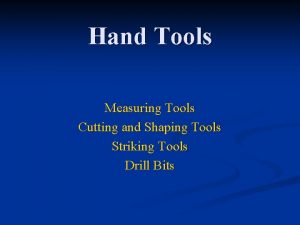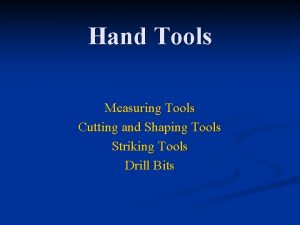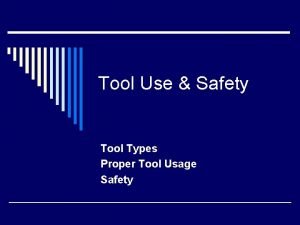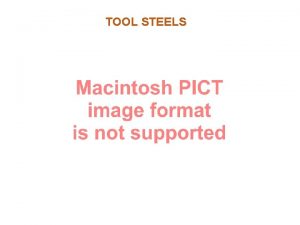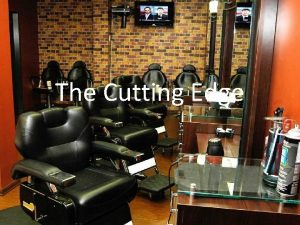Tool Time Power Tools Cutting Tools Cutting Tools
























- Slides: 24

Tool Time! Power Tools

Cutting Tools

Cutting Tools Many cutting tools were created for a specific purpose. Before we look at tools, lets look at the types of cuts we might make. • • Rip Cuts Cross Cuts Miter Cuts Bevel Cuts

Types of Cuts RIP CUT – Cut parallel to the grain of the wood CROSS CUT – cut perpendicular to the grain of the wood MITER CUT – angled cut on the face of the wood BEVEL CUT – angled cut to the edge of the wood

Table Saw A circular sawblade mounted under a table so that the blade projects up through a slot. The workpiece is pushed through the sawblade to create the cut. Best use: Rip cuts, bevel cuts Crosscuts are possible but ONLY with a crosscut sled. Miter cuts are possible but ONLY with a Miter Gauge.

Compound Miter Saw A circular sawblade mounted on a swing arm used to make a crosscut in a workpiece at a selected angle. Best use: Crosscuts, Miter cuts, Bevel cuts Rip cuts should never be done on a miter saw.

Circular Saw A handheld power-saw that uses a circular sawblade that spins rapidly around an arbor to produce a variety of cuts. Best use: A circular saw can handle rip cuts, crosscuts, and miter cuts and executes them all very well when used with a jig or fence. Many circular saws have a base plate that angles to allow for bevel cuts.

Reciprocating Saw AKA Sawzall A handheld power-saw in which the cutting action is achieved through a push-pull motion of the blade. Best use: All the things! But really – it is used primarily for demolition work. Do not use this saw for precise cuts. Note: You will commonly hear people refer to this as a Sawzall, which, like Kleenex, is a product name that has become a common term

Jigsaw A straight fine blade used to cut curves in a piece of wood. A jigsaw bridges the gap between cutting and shaping tools. A jigsaw can be used for rip cuts, crosscuts, and bevel cuts – however, the cut you get is typically far less clean than with a more appropriate tool. A jigsaw’s primary purpose is for cutting curves.

Bandsaw A long blade consisting of a continuous band of toothed metal stretching between two or more wheels to cut material. While a band saw, like a jigsaw, certainly can be used to make straight cuts which would make it more of a cutting tool, it is primarily used to cut curves making it, in many ways, a shaping tool.

Shaping Tools

Router A power tool with a shaped cutter for making grooves, joints and decorative edges.

Lathe A machine for shaping material by means of a rotating drive that turns the workpiece against changeable cutting tools.

Belt Sander A powered sander that uses a moving abrasive belt to smooth surfaces. Belt sanders are used for removing a lot of material, fast. Belt sanders are often used to smooth out very rough wood before going back over it with a finishing sander.

Orbital Finishing Sander A powered sander that typically uses a quarter sheet of sand paper (though many variations exist) moving in a rotating pattern to smooth surfaces. Finishing sanders are often used for fine sanding after another tool has been used for removing larger uneven material. Finishing sanders must be used to sand with the grain.

Random Orbit Sander A sander that uses a sandpaper disk that spins randomly causing it to produce less scratching across the grain than other sanders. Random orbit sanders have quickly become the sander of choice for most people. It can both remove a great deal of material without scratching the workpiece and also be used for finer finishing work. The only disadvantage is that the circular disk makes sanding into corners difficult.

Jointer and Planer Jointers and Planers are tools used for milling lumber – that is, making a piece of lumber flat and square. To truly get lumber where the faces are flat and smooth, opposing sides are parallel to one another and all corners are at 90 degrees both a jointer and planer are needed. The jointer is used to flatten one face and square up one edge. The planer is then used to make the second face flat and parallel to the first. Jointer Planer

Pneumatic Tools

Pneumatic Tools A pneumatic tool is any tool that is operated using pressurized air. To function in this way the tool must be connected via a hose to an air compressor. In this case, the tool itself is not really a power tool, though the air compressor does require power. Recently, many tools that were previously pneumatic have been getting the “cordless treatment” and run off rechargeable batteries like those used in other cordless power tools. This eliminates the need for the air compressor and removes the restriction of the hose. It adds, of course, the restriction of battery life. In these cases the tools are very much a “power tool” Many of the pneumatic tools look very similar which can make them hard to distinguish at a glance.

Crown Staplers fire, you guessed it, staples. The “crown” refers to the shape of the staple. Because of their shape they provide good holding power but create an obvious indentation in the wood which is fairly unattractive so you would either need to patch the holes or only use the staples where they won’t be seen.

Brad Nailer Brad nailers fire, well, brads. They are a thin gauge with a small head The great advantage of using a brad nailer is that because brads are thin gauged and the head is much smaller, you probably won't have to use wood putty to cover the hole. The disadvantage is that the thin gauge means less holding power which means having to potentially upgrade to a different nailer.

Finishing Nailer Finishing nailers fire finishing nails (sensing a pattern? ). They are very similar to brad nails except with a thicker gauge. The great advantage of using a finishing nailer is the increased holding power. However, along with the thicker nail comes a larger head which means there will be a noticeable hole where the nail went in that will have to be filled if it’s on a visible surface.

Framing Nailer Framing nailers fire the big daddy nails. These are the nailers that construction crews use to frame homes and other large construction projects. We won’t touch these in the scope of theatrical construction but it’s good to know they exist!

Angle Grinder While angle grinders can be a pneumatic tools, they are more often electric – they also just don’t really fit in just one other category. Angle grinders have various uses such as cutting, grinding and polishing. Different discs can be put in the grinder to suit different purposes. For us, angle grinders are most commonly used to grind down or cut off protruding metal such as screws or bolts that could pose a safety risk. Alternatively, we can also use the grinder to shape wood for prop making.
 The appropriate cutting tool used in cutting fabrics
The appropriate cutting tool used in cutting fabrics Power triangle formula
Power triangle formula Primary cutting edge angle
Primary cutting edge angle Inverted pen grasp
Inverted pen grasp Dental bur
Dental bur Orthogonal cutting is dimensional metal cutting
Orthogonal cutting is dimensional metal cutting Hand cutting tools in workshop
Hand cutting tools in workshop The reciprocating member of the shaper
The reciprocating member of the shaper Small ruler with sliding guide
Small ruler with sliding guide Cutting tools classification
Cutting tools classification Lathe cutting tool geometry
Lathe cutting tool geometry Theory of metal cutting
Theory of metal cutting Static marks
Static marks Cutting tool material
Cutting tool material Types of lathe tools
Types of lathe tools Lathe machine is useful for ______ process
Lathe machine is useful for ______ process Elastic energy
Elastic energy Sintering process meaning
Sintering process meaning Start time, end time and elapsed time
Start time, end time and elapsed time Potter's tool is data cleaning tool
Potter's tool is data cleaning tool Ribbon scissors floral design
Ribbon scissors floral design Holding tools examples
Holding tools examples Besly cutting tools
Besly cutting tools Fixtures related to cutting tools
Fixtures related to cutting tools Arc cutting tools
Arc cutting tools



